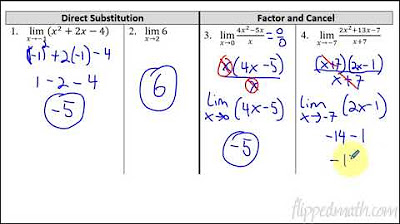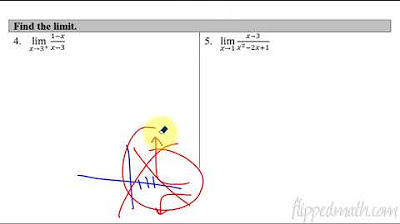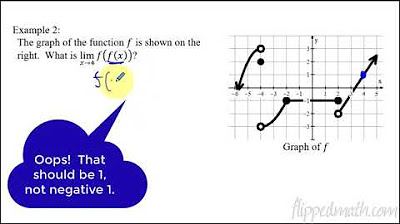Calculus AB/BC – 1.4 Estimating Limit Values from Tables
TLDRIn this calculus lesson, Mr. Bean teaches how to find limits using a table of values. He demonstrates how to use a graphing calculator, specifically a TI-84 Plus CE, to evaluate limits by plugging in values close to the target number. The lesson emphasizes the importance of understanding table and function notation and provides a step-by-step guide to accurately compute limits, even with rounding errors. Mr. Bean also highlights the significance of using radians for trigonometric functions and ensuring three-decimal precision for AP exams.
Takeaways
- 📚 The lesson is focused on finding limits in calculus using a table of values and a graphing calculator.
- ⚠️ A calculator is necessary for this lesson, with a graphing calculator being the most effective tool for the task.
- 📈 The concept of limits is illustrated by showing how the function's output approaches a certain value as the input gets closer to a specific number.
- 📉 The teacher demonstrates how to use a table of values to determine the limit as 'x' approaches a certain value, such as -4, using the function's behavior on both sides of the point.
- 🔢 The importance of using a graphing calculator to input functions and generate a table of values is emphasized for efficiency and accuracy.
- 💡 Two methods are shown for finding limits using a calculator: using the table of values and function notation, with the latter providing more precision.
- 🛑 The script explains that an error message in the table (e.g., undefined or divide by zero) is expected and helps confirm the limit's behavior.
- 📊 The teacher warns about the potential rounding errors in the table of values and suggests using function notation for more accurate results.
- 📚 The lesson includes a problem-solving example where the limit as 'x' approaches -2 is calculated using both table values and function notation.
- 📈 The concept of a function being continuous and increasing is introduced, which ensures the graph never dips and helps understand the behavior of 'y' values.
- 📝 The lesson concludes with a reminder to always round or truncate answers to three decimal places for AP exam standards.
Q & A
What is the main topic of Mr. Bean's calculus lesson?
-The main topic of the lesson is finding limits in calculus.
Why does Mr. Bean suggest using a calculator for this lesson?
-Mr. Bean suggests using a calculator because it helps in evaluating limits by filling in tables of values, especially when dealing with complex functions.
What is the significance of approaching a value in the context of limits?
-Approaching a value means getting very close to a specific number without actually reaching it, and observing the behavior of the function as it gets closer to that value.
What type of calculator does Mr. Bean recommend for this lesson?
-Mr. Bean recommends a graphing calculator, specifically mentioning the TI-84 Plus CE, for its ability to handle complex functions and tables of values.
Why does Mr. Bean emphasize the importance of using radians in trigonometric functions in calculus?
-Mr. Bean emphasizes using radians because calculus and physics often require calculations in radians, not degrees, for accuracy in functions like sine, cosine, and tangent.
What is the purpose of the table of values in evaluating limits?
-The table of values helps to visualize and understand the behavior of the function as the input variable approaches a certain value, showing the output values that the function approaches.
What is a potential issue with using a table of values for evaluating limits?
-A potential issue is that the table of values may have rounding errors, limiting the number of decimal places that can be displayed, which can affect the accuracy of the limit.
How does Mr. Bean demonstrate the use of function notation on a calculator?
-Mr. Bean demonstrates function notation by entering the function into a variable (e.g., y1) and then using that variable with different input values to quickly evaluate the function without retyping it each time.
Why is it important for a function to be continuous and increasing for the purpose of evaluating limits?
-A continuous and increasing function ensures that there are no breaks in the graph and that the function values consistently rise, which is crucial for accurately determining the limit as the function approaches a certain value.
What does Mr. Bean suggest regarding the number of decimal places to use when reporting the results of a limit calculation?
-Mr. Bean suggests using three decimal places when reporting the results of a limit calculation, as it is a requirement for the AP exam and ensures precision in the answer.
Outlines
📚 Introduction to Calculus Limits and Tools
In this calculus lesson, Mr. Bean introduces the concept of finding limits using a table of values and a calculator. He emphasizes the importance of having a calculator, especially a graphing one, for this lesson. The instructor explains the process of determining limits as 'X' approaches certain values from both sides, using a table to illustrate how 'Y' values approach a limit. He also demonstrates how to use a TI-84 Plus CE calculator to input functions and values, and how to navigate through table setups to find limits more efficiently.
🔍 Exploring Calculator Techniques for Limits
This paragraph delves deeper into the use of a calculator to find limits, highlighting the potential for rounding errors when using a table of values due to limited decimal places. The instructor introduces an alternative method using function notation, which provides greater accuracy. He demonstrates how to input the function into the calculator, use 'second enter' for quick repetition, and change input values to maintain accuracy. The lesson also covers the concept of a function being continuous and increasing, which ensures that the Y values are always rising, and applies this knowledge to confirm the limit as 'X' approaches a specific value.
📘 Final Thoughts on Accuracy and Rounding in Calculus
The final paragraph wraps up the lesson by emphasizing the importance of accuracy in calculus, particularly when dealing with limits and the use of calculators. The instructor explains the difference between rounding and truncating to three decimal places, which is a requirement for the 8P exam. He provides guidance on how to ensure that answers are presented with the correct number of decimal places, either by rounding or by truncating the values. The lesson concludes with a reminder to practice these skills for mastery and a look forward to the next lesson.
Mindmap
Keywords
💡Limit
💡Calculator
💡Graphing Calculator
💡Table of Values
💡Function
💡Continuous Function
💡Increasing Function
💡Function Notation
💡Trigonometric Functions
💡Radians
💡Decimal Places
Highlights
Introduction to the lesson on finding limits in calculus with Mr. Bean.
The necessity of a calculator for the lesson, with a preference for graphing calculators.
Explanation of limits with a table of numbers, emphasizing values approaching a specific point.
Graphical representation of limits and its comparison with a table of values.
Demonstration of finding the limit as X approaches a negative value using a table of values.
Introduction of the TI-84 Plus CE calculator for solving calculus problems.
Instructions on how to use the calculator to fill in a table of values for evaluating limits.
The importance of setting up the table correctly to avoid undefined values.
Using the table feature on a graphing calculator to input custom X values for limit evaluation.
The limitation of table width affecting the accuracy of displayed values.
Alternative method using function notation for more accurate limit evaluation.
Explanation of the function notation process on a calculator for inputting values.
The significance of a function being continuous and increasing for limit evaluation.
Clarification on how to interpret the limit of a function as it approaches a certain value.
Use of a calculator to find the cosine of a specific angle in radians for a limit problem.
Emphasis on the importance of using three decimal places for answers in calculus problems.
Different methods of rounding or truncating answers to three decimal places.
Conclusion of the lesson with a reminder to practice the concepts learned.
Transcripts
Browse More Related Video

Calculus AB/BC – 1.6 Determining Limits Using Algebraic Manipulation

Calculus AB/BC – 1.14 Infinite Limits and Vertical Asymptotes

Calculus AB/BC – 4.3 Rates of Change in Applied Contexts Other Than Motion

AP Calculus AB - 1.4 Estimating Limit Values from Tables

Calculus AB/BC – 1.5 Determining Limits Using Algebraic Properties

Calculus AB/BC – 1.9 Connecting Multiple Representations of Limits
5.0 / 5 (0 votes)
Thanks for rating: